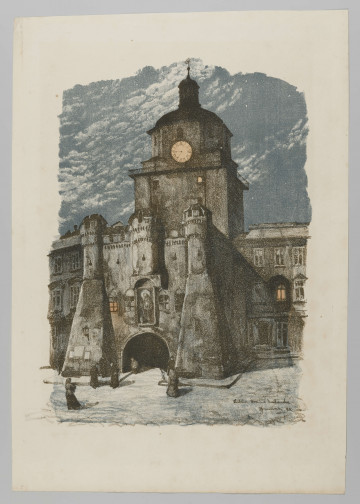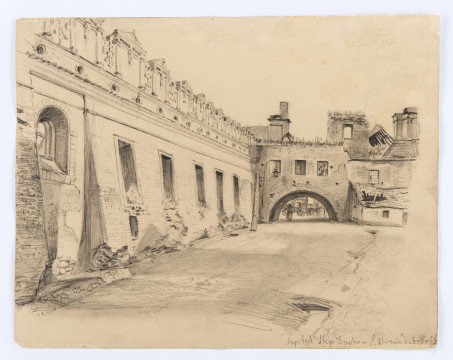
Lublin. Kraków Gate
1918
National Museum in Lublin
Part of the collection: Lubliniana. Painting views of Lublin and the Lublin Region
A view of a part of Krakowskie Przedmieście with the buildings of the Holy Spirit complex: the gate, the hospital and the church. Behind it, the outlines of the new town hall and the Kraków Gate.
The hospital church (rectory building) of the Holy Spirit was built in the years 1419-1421 outside of the city walls, in the Krakow suburbs. It was built out of the Lublin burghers founds next to the first brick hospital established in the 14th century. Originally, the Gothic church consisted only of a chancel and a nave. After fires in 1557 and 1602, it was rebuilt in the native style of the so-called Lublin Renaissance. In the 17th century, two chapels were built adjoined to it, and were incorporated into the church as side naves after the fire in 1733. At that time, the temple also received a baroque gable. The vestibule is from the end of the 18th century. In 1846, the tower was covered with a neo-Gothic roof.
There is an object of exceptional worship in the temple, the miraculous image of Our Lady of Good Counsel on which on July 18th, 1642, bloody tears appeared. The tears was noticed by Jakub Lenczowski, a student of post-Jesuit schools praying in front of the image. They were also seen by others, clergy and members of the congregation, who gathered in large numbers by the painting in the following days. Soon the image became famous due to numerous healings and favours experienced by the believers, praying also to the Mary to avert defeat in a time of wars that were dangerous for the country. Among others, Piotr Skarga, Stefan Czarniecki, Queen Marysieńka Sobieska, Marianna Kościuszkowa (Tadeusz’s cousin, a wife of Jan Nepomucen, owner of the nearby Sławinek) as well as Lublin townspeople and pilgrims asked for her intercession. The miracle and the process of the miracle inquest are commemorated by two monumental paintings of 1672 and 1673 hanging in the presbytery. Since the event, the believers had been leaving votive offerings in the temple. In 1748, there were several hundred of them in the treasury – gold, silver, set with precious stones; many of them, as well as the silver dress from the painting, chalices, and the monstrance were donated for national needs during the Kościuszko Uprising. Some of the other valuable objects include a fragment of the Renaissance triptych with the scene of the resurrection of Piotrowin by St. Stanisław, as well as tombstones, including those of Anna Daniłowicz née Dönhoff from 1730 and Marianna Kościuszkowa, who died in 1800.
Renata Bartnik
Author / creator
Dimensions
cały obiekt: height: 21,9 cm, width: 18,8 cm
Object type
graphics
Technique
lithography
Material
paper
Creation time / dating
Creation / finding place
Owner
The National Museum in Lublin
Identification number
Location / status

1918
National Museum in Lublin

1814
National Museum in Lublin

1853
National Museum in Lublin
DISCOVER this TOPIC
Museum of King Jan III's Palace at Wilanów
DISCOVER this PATH
Educational path